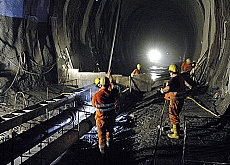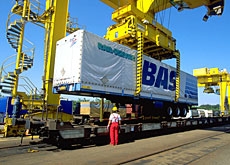Lötschberg tunnel preparations on track

Preparations for the opening of the Lötschberg rail tunnel - one of two high-speed links being built under the Alps - are right on schedule, say its builders.
However, there are a number of hurdles to overcome if trains are to run as planned in a year’s time, with questions being raised about the reliability of a new control system.
With one year to go before the new base tunnel is fully operational on December 9, 2007, preparations are running according to the project timetable.
The Lötschberg is under construction in parallel with its big brother, the new Gotthard tunnel, as part of an overall plan by the Swiss government to create a more efficient rail network and help ease the heavy burden of transalpine traffic.
On completion, around 110 trains will use the new Lötschberg every day. The tunnel will bring cantons Bern and Valais closer together, shaving travel time by a third between the capital and Brig, and shortening the journey between Germany and Milan by an hour.
Most of the major work on the Lötschberg is complete.
“But one more year of effort is required,” explained Max Friedli, director of the Federal Transport Office.
Testing
An intensive test phase began at the beginning of December, with the first trains travelling the length of the Lötschberg’s 34.6 kilometres.
Mathias Tromp, director of the tunnel operating company BLS, estimates that a total of 10,000 trains – including loaded goods wagons – will test the new route over the next 12 months at speeds of up to 280 km/hour.
Besides final technical work and thorough testing, one major challenge ahead involves the integration of the Lötschberg into the national rail timetable.
“It’s our greatest challenge, as the Lötschberg base tunnel runs on only one track for 22 of its 35 kilometres,” said Tromp, who added that he “could have done without” this additional constraint imposed for economic reasons by parliament.
“We have to do our utmost to make sure the trains are on time,” he warned.
Around 42 passenger trains – 30 between Bern and Valais and 12 to and from Milan – and up to 80 goods trains will use the new high-speed link on a daily basis, with 40 more continuing to take the old rail route via Kandersteg and Goppenstein.
Faced with such a potential bottleneck, any trains arriving late at the new tunnel will be “slow-tracked”.
“As soon as a train is more than seven minutes late, we will have to make it wait until a window opens up or it’ll have to use the old route,” Tromp explained.

More
New Rail Links through the Alps
Control system
Another challenge involves ensuring that the new European standard signalling system – the Level 2 version of the European Train Control System (ETCS) – functions perfectly. The ETCS allows trains to travel at much higher speeds by relaying messages from track sensors straight to the driver’s cab, doing away with the need for traditional signals.
The system is already in use on the new Bern-Olten high-speed rail link but has experienced several technical problems, admits Hansjörg Hess, head of infrastructure at the Federal Railways.
And the new national train timetable, to be published in December 2007, is dependent on ETCS 2 operating at 100 per cent in the Lötschberg.
But those in charge remain confident that, on the basis of detailed risk analysis, trains will run on time and the tunnel will be fully operational by the end of next year.
The transport director stressed the timesaving benefits of the new tunnel and in particular its impact on the public’s perception of travelling by train and distances.
“The Upper Valais region will practically become part of the central Plateau region, and Milan will be almost integrated into the Swiss urban train network,” said Friedli.
swissinfo, Simon Bradley
Length of Lötschberg base tunnel – 34.6 kilometres.
Separation between the tubes – 40 metres.
Elevation at the Frutigen north portal – 776.5m above sea level.
Elevation at the Raron south portal – 654.2m above sea level.
Length of track system – 57 km.
Number of workers – 2,500.
Maximum speed – 250km/hour.
Number of trains per day – 110.
Additional capacity of goods trains using the tunnel: 7 million tons (+62%).
Projected travel time from Bern to Sion: 1.5 hours (-45min.).
Projected travel time from Basel to Milan: 4 hours (-1hr.).
The Lötschberg base tunnel, which is part of the New Railway Links through the Alps (NRLA) project, runs from Frutigen in the Kander valley to Raron in canton Valais.
The Lötschberg was originally envisaged as a two-tunnel system. But budget cuts have meant that in parts the tunnel will consist of just one tunnel, so that trains going in opposite directions will have to share the track.
The first goods trains will be able to use the tunnel from June 16, 2007. A full passenger service will start from December 9, 2007.
The Lötschberg is expected to cost SFr4.3 billion ($3.59 billion), up from the initial estimate of SFr3.2 as a result of “security improvements”, according to AlpTransit.
The overall approved budget for the whole NRLA project (Lötschberg, Gotthard and Ceneri tunnels) of SFr12.6 billion could well rise to SFr24 billion.

In compliance with the JTI standards
More: SWI swissinfo.ch certified by the Journalism Trust Initiative













You can find an overview of ongoing debates with our journalists here . Please join us!
If you want to start a conversation about a topic raised in this article or want to report factual errors, email us at english@swissinfo.ch.